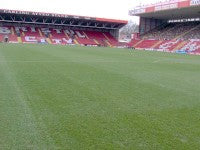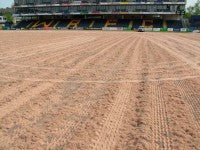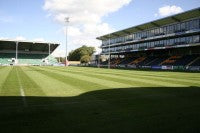The 'F' Plan
 Top class sport continues to demand ever improving playing surfaces as games become faster and more skillful. Many stadium pitches are being used more and more, not just for sport but also for events such as concerts and exhibitions. Another recent trend has seen stadiums used for duel sports with football and one of the two rugby codes pitch sharing. It is a scenario that has put extra pressure on the groundsmen at these venues.
Top class sport continues to demand ever improving playing surfaces as games become faster and more skillful. Many stadium pitches are being used more and more, not just for sport but also for events such as concerts and exhibitions. Another recent trend has seen stadiums used for duel sports with football and one of the two rugby codes pitch sharing. It is a scenario that has put extra pressure on the groundsmen at these venues.
This increased usage would not be possible without the technical advancements in pitch construction and improved maintenance regimes.
It would have been impossible to hold these extra events in the 1970's and early 1980's on the poor quality, muddy, soil based pitches of that era. But, with the top venues having gone through radical reconstructions and refurbishments in recent years, the opportunity to gain extra revenue from holding these events is now an important factor for many clubs.
The main challenge was to improve drainage and surface playability, while reducing wear and tear. This was made possible with the introduction of sand dominated rootzones in the mid 1980's.
However, these early pitches were not as successful as had been hoped due to a lack of understanding of how to maintain them or an incorrect choice of sand materials.
Sand is a very inert material; free draining but prone to compaction. The problem was the sand profile drying out. Sand becomes unstable as it dries out, and has a tendency to move laterally.
This, in turn, made the pitch unstable and soon the grass was being kicked out, and became a serious issue during the winter months when there was little or no chance of the grass recovering. Many of these early sand constructed pitches often resembled a beach in the winter months due to the loss of grass cover. However, help was at hand when, in 1991, Vic Armond of Mansfield Sand developed the fibresand product. 
FIBRESAND is silica sand that is mixed with millions of polypropylene 35mm long fibres. The fibresand is then further mixed with soil to form a reinforced 80/20 rootzone material that turf can be grown on. This formula produces a product that gives immense threedimensional strength and stability. The fibres have a stabilising effect by reducing surface deformation and compaction effects from footfall or vehicle traffic.
The first football club to use Fibresand was Hull City in the 1991-92 season to reinforce their goal mouths and centre circle. Hull were so pleased with the results that, at the end of the following season, they increased the amount of fibre into their pitch by a further 31 tonnes of the material using two methods of application.
The goal mouths and penalty boxes were completely stripped out and replaced with fibre rootzone materials, while other areas of the pitch were top dressed with the fibresand, using solid tine aerators to punch the material into the ground.
Manchester United were next to try out the method, having 121 tonnes incorporated into the Old Trafford pitch
TOP class sport continues to demand ever improving playing surfaces as games become faster and more skillful. Many stadium pitches are being used more and more, not just for sport but also for events such as concerts and exhibitions. Another recent trend has seen stadiums used for dual sports with football and one of the two rugby codes pitch sharing.It is a scenario that has put extra pressure on the groundsmen at these venues.
in 1993. Then, in 1998, the whole pitch was reconstructed using fibresand for the upper rootzone. This revolution in turf maintenance and management techniques vastly improved the durability of the playing surfaces which, inevitably, led to a wider choice of reinforced sand/soil amendments. Desso, Extragrass and Locksand have all have been designed to improve surface sustainability.
 However, it is Mansfield's Fibresand that seems to be the popular choice, with over 100 football and rugby clubs in the UK and abroad now using the product in either their stadium or training pitch facilities.
However, it is Mansfield's Fibresand that seems to be the popular choice, with over 100 football and rugby clubs in the UK and abroad now using the product in either their stadium or training pitch facilities.
The new Wembley Stadium is one of several venues that has been constructed or renovated using Fibresand. Others include Leyton Orient, Luton Town, Burton Albion, the new Doncaster Rovers Community pitch and Worcester Warriors Rugby Union Club at Six Ways
Worcester.
A typical Fibresand construction consists of a 100mm depth of fibre reinforced sand/rootzone material laid on to a lower 150mm rootzone - both sit on top of a fully integrated drainage system that promotes rapid drainage rates.
A high sand content, typically 80% by weight, is used to promote good surface drainage characteristics.
The life span of these Fibresand pitches depends on how well they are maintained. The key is to establish a good cover of grass, that has a deep rooting structure, and to carry out the appropriate pitch renovations at the end of each playing season.
With Fibresand groundsmen are able to carry out all cultural practices including scarifying and deep aeration.
Successful management of these surfaces is based around normal maintenance techniques such as irrigation, feeding, brushing, mowing and aeration.
Surface Hygiene
It is essential that the sward remains clean and open, with no organic build up present. Good mowing practices, along with scarification and verti-cutting, should be backed up with sweeping and collecting of any decaying matter, particularly after matches or events.
A clean interface between the individual grass plant and the rootzone is essential if the pitch is to continue to drain and hold together during periods of dormancy.
Surface hygiene assists in the prevention of disease or the build up of black layer or algae. Surface accumulations of thatch and decaying material will also impede the passage of surface water.
The sward should be brushed, using pedestrian drag brushes, as a matter of routine, to disperse morning dew and to stand the plant upright. One other form of brushing which will be required periodically is a tractor mounted drag brush for a deeper agitation of the Fibresand materials.
Irrigation
It is essential to have an efficient automated watering system that can deliver a uniform covering of water. A policy of drench and drain should be adopted in order that the roots of the grass will follow the water down through the rootzone profile.
Irrigation should not be undertaken on a little and often basis as this will encourage shallow rooting and Poa annua infestations.
During preparation for matches the immediate surface should not be allowed to dry out as this may lead to a reduction in surface stability. On occasions it will be beneficial to lightly water the surface prior to matches, particularly during periods of dry weather.
Aeration
Aeration is a vital component in producing a sward able to withstand the rigours of a full season's use. It serves many purposes and can be undertaken in different forms but, in the main, aeration should be carried out using punch action equipment.
Vary the depth and diameter of tines between 8mm - 12mm, ensuring they penetrate through the fibresand profile.
Working depth and surface heave should be set to suit conditions, and the tine spacing set at between 75mm to l00mm depending on the size of the tines being used.
These machines can be best utilised if fitted with needle tines which aerate the surface at close centres. This action maximises the air filled porosity of the rootzone while, at the same time, causes minimal surface disruption with less rootzone compression around the tine holes. However, remember that a fine line exists between aerating the surface and destabilising it during the winter months.
Although aeration is important during the playing season its use in the summer months is even more important, since aeration during the growing season will promote a deeper rooting sward. Ideally, clubs should have their own aeration equipment, as this enables the grounds staff the flexibility to do the work at their own discretion. Timing is everything especially when influenced by the weather, fixtures or condition of the pitch.
Mowing , Scarification & Verticutting
Mowing is one of the most vital operations required on a regular basis the production of a healthy sward. Presentation is also much enhanced by correct mowing techniques. It is an essential all the year round operation and the machine should be set at a
suitable height (25-27mm) to provide a relatively short, quick surface.
Scarification and verti-cutting will be of paramount importance if a clean, open sward is to be maintained. These operations need to be carried out on a regular basis particularly during the growing season. They will enhance presentation throughout the playing season and reduce the risk of organic build up and disease infestation, which can be costly to rectify.
Pitch analysis
It is imperative that the groundsman keeps a working diary detailing the maintenance regimes undertaken and the condition of the pitch, as this data can be used effectively to decide on any future maintenance or renovation works required.
It is important to monitor nutrient levels, as sand based pitches are renowned for leaching nutrients from their profiles. Also, keep an eye on root depth and check on its aerobic state and hardness.
Russell Latham, of Mansfield Sands,also carries out inspections of his customers' facilities. This includes a soil analysis to check the fibre / sand ratios and also three separate Clegg Hammer tests during the year to check on the hardness of the pitch. Russell takes 144 Clegg Hammer readings on each pitch, to obtain a mean gravities value.
The FA have stipulated that a pitch must achieve a Clegg Hammer reading of between 35-200 gravities. Using the STRI method of test with a 0.5kg Clegg Impact Hammer from a drop height of 0.55 m, the ideal reading for optimum play should be between 120 -140
gravities.
Nutrition
Sand based pitches are notorious for leaching nutrients so, to help promote and sustain health grass growth, a suitable, regular fertiliser programme is required.
Fertiliser/soil improvers may be applied in either the form of a granular top dressing, or as a liquid foliar feed using accurately calibrated sprayers and spreaders.
End of season Renovations
Fibresand pitches are completely suited to modern day end of season renovation techniques. For major works it is advisable to employ the services of a competent contractor who has the relevant expertise and machinery to carry out such work.
End of season renovation should be determined by the condition of the pitch prior to the end of the playing season and should be assessed at the appropriate time.
In most cases pitch quality will change over time. Having started with an ideal sward composition, and free draining, you may be faced with a changing surface environment once the ravages of play take their toll.
By the very nature of the maintenance required, plenty of watering and a constant feeding programme, the sward goes through many cycles of growth which, in turn, produces a lot of thatch and dead vegetation. If left to accumulate it will eventually slow water infiltration and provide an ideal climate for disease and proliferation of Poa grasses.
However, with the advent of the Koro Field Top Maker, the job of renovating football pitches has been made more effective, with an opportunity to clean out all weak grasses and leave the desirable ones. Or it can be utilised to completely remove all surface vegetation to leave you with a new clean surface to prepare and over sow.
In the past the Koro was generally used on a two-year cycle, but now, where budgets allow, some clubs will use it as part of their annual renovation programme.
Generally, there are four renovation options for Fibresand pitches:
1. Annually - The basic renovation technique is to scarify in several directions to thin out the sward, top dress with a compatible root zone, fertilise and overseed.
2. Annually - Use the Koro to remove 20mm of surface vegetation, top dress and overseed.
3. Bi-annually - Complete removal of all vegetation, restoring levels, top dressing, fertilising and overseeding.
4. Every 4-5 years - Complete Koro removal of all the vegetation, power harrowing the complete profile to introduce new air spaces and then top up with new Fibresand materials, roll, fertilise and overseed.
There are many preconceived notions about Fibresand pitches and how they perform. The initial cost of the materials, the pecialist work involved to maintain them, and the perception that they are hard and unforgiving are common misgivings. However, talk to most groundsmen maintaining them and they will sing their praises. Long gone are the days of having to spend 3-4 days hand divoting and repairing pitches.
After match damage of a Fibresand pitch, when maintained correctly, should be minimal - just minor scarring that can usually be put right in a quarter of the time.
And hardness? It is all about management of the profile, regular aeration, and the fact that groundsmen can maintain a quality sward, which will dictate the resilience and hardness of the playing surface.
At the end of the day it is about the skill and expertise of the groundsman and how he uses his resources and equipment to manage the pitch.
